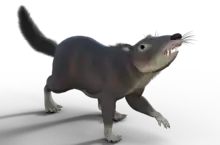Cronopio (mammal)
Cronopio is an extinct genus of dryolestoid mammals known from the Río Negro region of Argentina.[1]
| Cronopio | |
|---|---|
 | |
| Restoration | |
| Scientific classification | |
| Kingdom: | Animalia |
| Phylum: | Chordata |
| Class: | Mammalia |
| Order: | †Dryolestida |
| Clade: | †Meridiolestida |
| Genus: | †Cronopio Rougier et al. 2011 |
| Species: | †C. dentiacutus |
| Binomial name | |
| †Cronopio dentiacutus Rougier et al. 2011 | |
Description
Cronopio is known from the holotype MPCA PV 454, a partial skull which is missing the skull roof, basicranium and squamosals and from the referred specimens MPCA PV 450, a partial left lower jaw with damaged teeth and MPCA PV 453, an incomplete skull with a relatively complete right lower jaw missing some teeth. All specimens were collected in La Buitrera locality, from the Candeleros Formation of the Neuquén Group, dating to the early Cenomanian stage of the early Late Cretaceous, about 99.6-96 million years ago.[1]
Paleontologist Guillermo Rougier commented on the creature's "superficial" resemblance to the fictional character Scrat in the film Ice Age (2002), saying "it just goes to show how diverse ancient mammals are, that we can just imagine some bizarre critter and later find something just like it."[2]
Etymology
Cronopio was first named by Guillermo W. Rougier, Sebastián Apesteguía and Leandro C. Gaetano in 2011 and the type species is Cronopio dentiacutus. The generic name is named after the fictional characters appearing in the work of Argentinian writer Julio Cortázar.[1][3] The specific name is derived from Latin, meaning "sharp-toothed".[1]
Phylogeny
Cladogram following the analysis of Rougier, Wible, Beck and Apesteguía (2012):[4]
| Dryolestoidea |
| ||||||||||||||||||||||||||||||||||||||||||||||||||||||||||||||||||||||||||||||||||||||||||
References
- Guillermo W. Rougier; Sebastián Apesteguía; Leandro C. Gaetano (2011). "Highly specialized mammalian skulls from the Late Cretaceous of South America". Nature. 479 (7371): 98–102. doi:10.1038/nature10591. PMID 22051679, supplementary information.
- "Ice Age Reality?". Calgary Sun. November 9, 2011. p. 22.
- Barras, Colin (2 November 2011). "Sabre-toothed squirrel scurried at dinosaurs' feet". Life. New Scientist. Retrieved 2011-11-04.
- Guillermo W. Rougier; John R. Wible; Robin M. D. Beck; Sebastian Apesteguía (2012). "The Miocene mammal Necrolestes demonstrates the survival of a Mesozoic nontherian lineage into the late Cenozoic of South America". Proceedings of the National Academy of Sciences of the United States of America. 109 (49): 20053–20058. doi:10.1073/pnas.1212997109. PMC 3523863. PMID 23169652.




